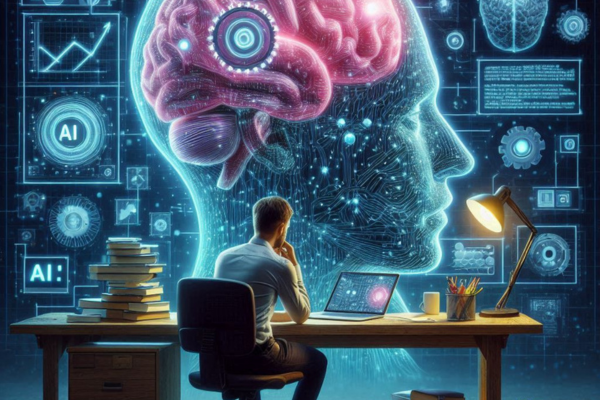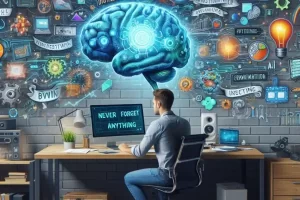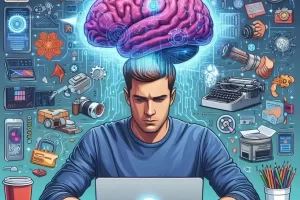In a world where information is everywhere, learning isn’t the hard part — retaining and applying what you learn is. You watch a course, read a book, or attend a webinar, only to forget most of it days later. That’s where your second brain comes in. And when powered by artificial intelligence (AI), it becomes the ultimate system for learning faster, remembering more, and growing continuously.
In this article, you’ll discover how to use your AI-enhanced second brain to transform how you learn — from passive content consumption to active knowledge creation.
Why Most Learning Doesn’t Stick
You’ve probably experienced this before:
- You read a great article but can’t recall it a week later
- You take notes in a course but never revisit them
- You get overwhelmed by the amount of information and don’t know what to do with it
This happens because:
- We rarely review what we learn
- Notes get buried or forgotten
- We don’t connect new learning to prior knowledge
Your second brain changes that. It allows you to:
- Capture learning moments quickly
- Organize them by theme and topic
- Review regularly using AI
- Connect ideas across time and context
- Generate output from your input
Let’s see how to build this process.
Capture Learning in Real Time
Every learning moment is valuable — but only if you capture it before it fades.
Use tools like:
- Readwise to save highlights from Kindle, articles, and podcasts
- Notion or Obsidian to store structured notes
- Otter.ai to transcribe voice memos from classes or lectures
- ChatGPT to summarize dense content as you consume it
Prompts to try:
“Summarize this video transcript in 5 bullet points.”
“Turn this podcast episode into key takeaways.”
“Extract the top 3 lessons from this article.”
By capturing while learning, you lock in value before it disappears.
Use AI to Turn Notes Into Knowledge
Raw notes are often messy and inconsistent. AI helps turn them into usable, structured information.
Ask ChatGPT or Notion AI to:
- Summarize lecture notes
- Organize takeaways by topic
- Turn scattered bullet points into a paragraph explanation
- Extract definitions and frameworks from complex texts
Example prompt:
“Turn these class notes into a study guide with headings.”
“What is the core message of this chapter, and how does it relate to habit formation?”
This step transforms your second brain into a learning processor, not just a storage folder.
Link New Learning to Old Knowledge
True understanding comes from connection. AI can help link what you’re learning now to what you already know.
Prompts:
- “What notes in my second brain are related to this concept?”
- “Does this idea connect with anything I’ve learned about leadership/productivity/psychology?”
- “Find a pattern between these new notes and my older ones about focus.”
This practice creates a network of knowledge instead of isolated notes.
Practice Spaced Repetition with AI
One of the best ways to retain what you learn is through spaced repetition — reviewing information at intervals until it’s embedded.
Ways to implement this:
- Use Readwise to resurface highlights daily
- Use Notion AI to quiz you on content from last week
- Ask ChatGPT:
“Review my notes from two weeks ago and generate 3 quiz questions.”
“What concepts have I not reviewed in the last 30 days?”
The AI helps you build memory by automating recall.
Create Evergreen Learning Notes
Instead of endless disconnected notes, build evergreen notes — curated summaries of what you’ve learned that evolve over time.
Each note should:
- Capture core ideas in your own words
- Include links to source material
- Be updated as your understanding deepens
- Connect to other concepts in your second brain
Ask AI to help:
“Create an evergreen note on growth mindset from these course notes.”
“How does this new insight update my evergreen note on productivity?”
These notes become your personal knowledge base.
Generate Output from Learning
The best way to retain knowledge is to use it. Turn your learning into:
- Blog posts
- Video scripts
- Mind maps
- Teaching content
- AI summaries for your audience
Prompts to try:
- “Create a blog outline from this book summary.”
- “What are 3 ways I can apply this concept at work?”
- “Summarize this topic as if I’m teaching it to beginners.”
Learning becomes more than passive consumption — it becomes creation.
Review Weekly with AI
Each week, let your second brain and AI summarize what you’ve learned.
Ask:
- “Summarize all new notes added this week.”
- “What were the main topics I studied?”
- “What should I revisit or go deeper on next week?”
This habit reinforces memory and guides your future learning.
Bonus: Set up a Notion or Obsidian dashboard that updates automatically with:
- New learning notes
- Concepts to review
- Progress on study goals
Real-Life Example: The Self-Learner’s Workflow
Let’s say you’re learning UX design on your own. Your second brain might:
- Store video course notes, structured by module
- Use AI to summarize and quiz you on each section
- Connect principles of UX to past notes on psychology
- Turn your takeaways into a blog post or project brief
- Surface old concepts each week to review and expand
This process turns learning into mastery, and your second brain becomes the engine.
Final Thoughts: Learn Less. Remember More. Apply Often.
In an era of information overload, learning faster and remembering more isn’t about speed — it’s about systems.
With your second brain and AI, you don’t have to fear forgetting what you learn. You can build a process that captures, connects, and applies everything — so knowledge becomes part of who you are, not just something you once read.
Let AI help you learn like never before. With consistency, you’ll create a second brain that grows with you — and helps you grow faster.




